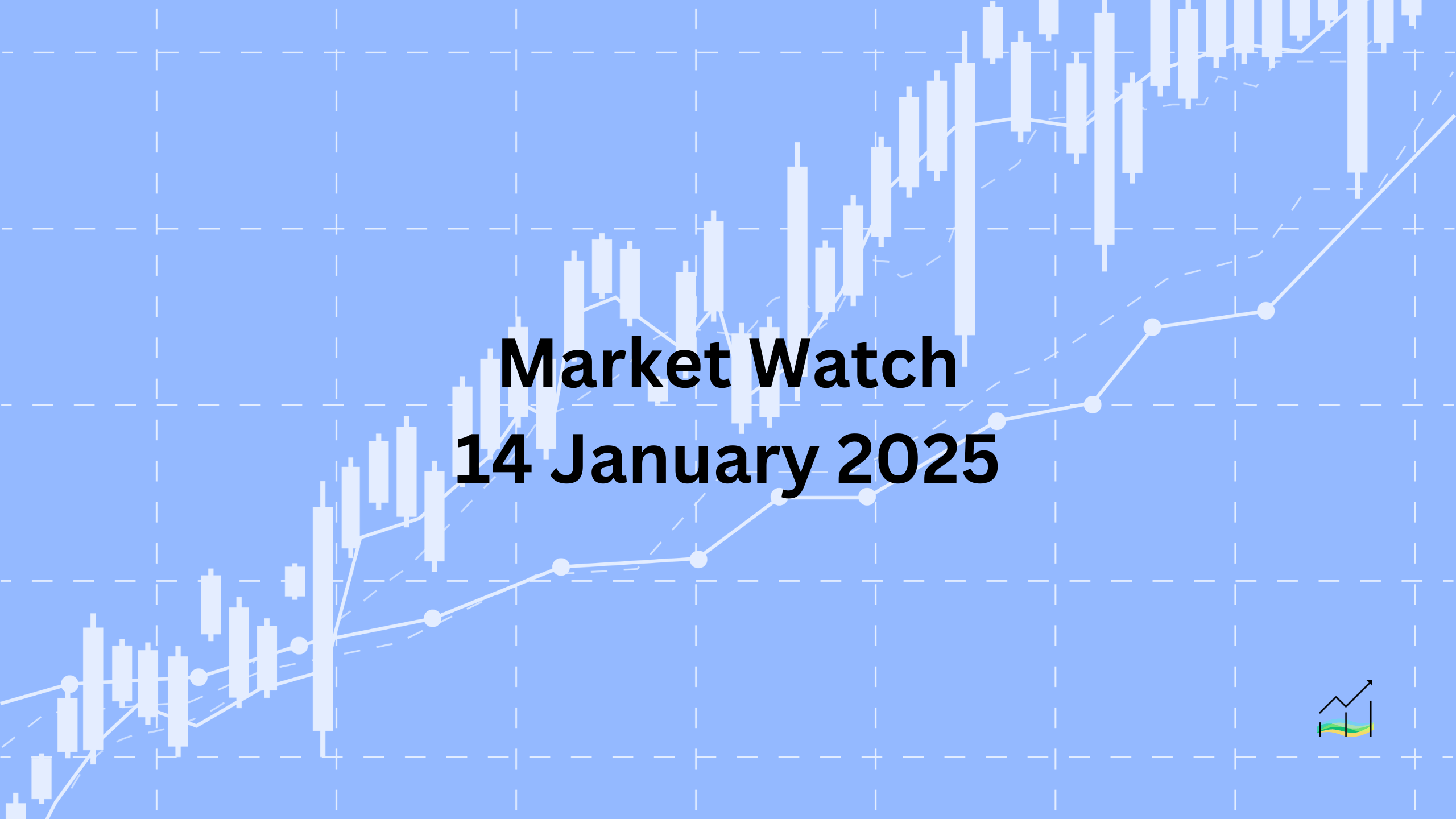14/01/2025 Market Watch

Dollar Softens, Equities Rebound & Yields Steady
The dollar softened against most G10 and emerging market currencies, indicating a corrective phase following initial gains in North American trading. With a flurry of news already absorbed, markets are eyeing October for the next Fed rate cut, amidst the release of US PPI and CPI data. Reports suggest US tariffs may be implemented in stages, potentially doubling average non-China tariffs, though described as "moderate."
Equity markets saw a rebound, with the S&P 500 recovering after filling the post-election gap. Most Asia Pacific markets rallied, led by a 2.6% gain in China’s CSI 300, while Japan lagged. Europe’s Stoxx 600 rose 0.5%, recovering from previous losses, and US index futures gained 0.4%-0.7%.
Bond yields were mostly softer, with the UK’s 10-year Gilts yield slightly down, while the 10-year US Treasury yield remained steady near 4.77%. Gold steadied after a 1% decline, and WTI crude consolidated above $78 after peaking near $79.25.
United States of America
Market sentiment may have peaked as the derivatives market shifted expectations for the next Fed rate cut from mid-2026 to Q4 2025. This adjustment comes amid reports of the new US administration considering phased tariff increases, with monthly hikes of 2-5% being described as "moderate." Notably, the average US tariff in 2023, excluding China, was under 3%.
Attention is now on upcoming inflation data, with the PPI expected to accelerate and the CPI projected to rise, though core CPI may remain steady. The Fed appears in no rush to follow up on the 100 basis points of cuts implemented between September and December 2024, a stance differing from other G10 central banks except for the Bank of Japan. This divergence has supported the dollar's ongoing rally, with the Dollar Index up 10% from its September lows, two-thirds of which occurred post the November 2024 election. The current consolidation is viewed positively, as the Dollar Index holds above 109.30.
Key Points:
- Fed rate cut expectations adjusted from mid-2026 to Q4 2025.
- US tariff increases may be implemented in stages, with 2-5% monthly hikes termed "moderate."
- PPI and CPI data are anticipated to show inflationary pressure.
- The Fed is not in a hurry to cut rates further, contrasting with most G10 central banks.
- The Dollar Index has rallied 10% since September, with current levels above 109.30.
Australia & New Zealand
The Australian dollar rebounded yesterday after a four-day decline, hitting a low of $0.6130, the weakest since April 2020. Despite weaker consumer confidence data from Westpac-Melbourne, corrective forces lifted the Aussie to a three-day high, slightly above $0.6705. Resistance is expected around $0.6215-35.
Similarly, the New Zealand dollar reached a new low since October 2022 (~$0.5540) before recovering to session highs near $0.5585. Continued buying pressure today tested the $0.563-35 area, holding initially. A break above this level could push the Kiwi toward $0.5700.
Key Points:
- The Australian dollar recovered from a four-day drop, hitting a low of ~$0.6130.
- Resistance for the Aussie is near $0.6215-35.
- The New Zealand dollar hit a low of ~$0.5540 and recovered to session highs.
- Breaking above the $0.563-35 level could drive the Kiwi toward $0.5700.
Canada
The US dollar reached a marginal five-day high near CAD1.4450 yesterday before reversing and settling at a low around CAD1.4375. Today’s adjustments pushed it slightly below CAD1.4345 before recovering during European trading. The dollar has been trading within a CAD1.4280-CAD1.4450 range since January 6. A close below CAD1.4375-85 could trigger a test of the range’s lower boundary.
The five-day moving average crossed above the 20-day moving average in early October but might cross down soon due to the sideways market, which often causes whipsaw effects on moving averages. The momentum indicators have moved lower, yet they remain stretched due to the ongoing sideways trend.
Key Points:
- The US dollar hit a five-day high near CAD1.4450 before reversing to CAD1.4375.
- It has been trading in a CAD1.4280-CAD1.4450 range since January 6.
- A close below CAD1.4375-85 could test the range’s lower end.
- The five-day moving average could cross below the 20-day moving average soon.
- Momentum indicators are lower but still stretched amid the sideways trend.
China
Last month and early this year, Beijing successfully kept the dollar below CNY7.30. However, the dollar broke above CNY7.32 on January 3, reaching nearly CNY7.3330 by the end of last week. This week, it has traded within a tight range of ~CNY7.3280-CNY7.3320. Today’s reference rate for the dollar was set at CNY7.1878, with rates so far this year ranging narrowly between CNY7.1876 and CNY7.1891.
Against the offshore yuan, the dollar remains within the range established on December 31 (~CNH7.3055-CNH7.3700). China reported better-than-expected lending data for December, with aggregate financing rising by 9.7%, the strongest in three months. However, annual aggregate lending fell for the first time since 2021, nearly offsetting the 2023 increase.
Key Points:
- The dollar broke above CNY7.32 on January 3, reaching ~CNY7.3330.
- This week, the dollar has held a range of ~CNY7.3280-CNY7.3320.
- Today’s reference rate was CNY7.1878, with a tight range this year.
- The dollar trades within ~CNH7.3055-CNH7.3700 against the offshore yuan.
- December’s aggregate financing in China rose 9.7%, but annual lending fell for the first time since 2021.
Europe
The swaps market anticipates the European Central Bank (ECB) will cut rates by 75-100 basis points this year, creating a sharp contrast with US expectations, even without the threat of US tariffs. The euro, which had been declining for four days, bounced back yesterday and continues to trade higher, gaining nearly a cent from its recent low. It is now approaching $1.0280, with a move above $1.0300 potentially stabilizing its technical outlook, although significant movement is unlikely before the US CPI release tomorrow.
In France, Prime Minister Bayrou is set to present budget proposals amid low public support, which stands at around 20%. The central bank governor emphasized the need for a deficit projection close to 5%, but under 5.5%, to maintain government credibility. Adjusting the controversial law that raised the retirement age from 62 to 64 could garner support from the Socialist Party. In early week trading, options at $1.02 for around 7 billion euros expired, with initial support near $1.0240.
Key Points:
- The ECB is expected to cut rates by 75-100 basis points this year.
- The euro rebounded from a four-day decline, nearing $1.0280.
- A rise above $1.0300 could stabilize the euro, pending US CPI data.
- French budget proposals come amid low support for PM Bayrou.
- Adjustments to the retirement age law may gain Socialist Party backing.
- Initial euro support is near $1.0240.
Japan
BOJ Deputy Governor Himino delivered a balanced speech, indicating that a rate hike will be on the agenda at next week's meeting (January 23-24). Since mid-December, market rates have fluctuated between 10 and 15 basis points, currently at the upper end of that range. Himino and Governor Ueda acknowledged uncertainties from the new US administration.
Japan's current account balance typically worsens in November compared to October, but last year was an exception. An unexpected trade surplus of JPY97.9 billion, compared to a deficit of JPY155.7 billion in October, contributed about a quarter of the improvement. The majority of the enhancement came from increased overseas investment income, including interest, dividends, royalties, licensing fees, and remittances.
Yesterday, the dollar dipped below its 20-day moving average (~JPY157.15) for the first time since December 12 but rebounded today, approaching yesterday's high (~JPY158). The recent high, recorded after the US employment data, slightly exceeded JPY158.85.
Key Points:
- BOJ to discuss a potential rate hike next week.
- Market rates have fluctuated between 10-15 basis points, now at the upper end.
- Japan's current account balance improved due to a trade surplus and overseas investment income.
- The dollar dipped below its 20-day moving average but rebounded, nearing JPY158.
United Kingdom
Sterling has dropped over 3% against the dollar in the past five sessions, losing approximately five cents, marking it as the weakest performer among the G10 currencies. The Swedish krona follows closely, with a 2% decline. Sterling's downturn seemed to find some relief yesterday, testing the $1.21 level, followed by a recovery that reached $1.2250 today before pausing. Chancellor Reeves is set to address Parliament soon, with discussions likely to include her recent visit to China and the rising Gilt yields.
Sterling's significant drop contrasts with its two-and-a-half-year high near $1.3435 last September. Tomorrow, the UK's December CPI report is due, with expectations that the headline figure will remain steady at 2.6%, while the core and services measures may see a slight decline.
Key Points:
- Sterling fell over 3% in five sessions, the weakest among G10 currencies.
- It tested $1.21 before recovering to $1.2250.
- Chancellor Reeves' upcoming Parliament discussion may touch on rising Gilt yields.
- UK December CPI is expected to remain steady, with minor softening in core and services.
© 2025 SKONE Enterprise (003319453-V). All rights reserved.
The content on this site is for informational purposes only and does not constitute financial advice.


